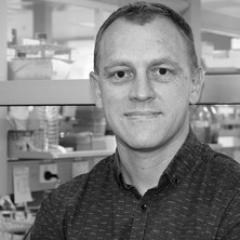We study protein structures, using methods including X-ray crystallography, cryo electron microscopy (cryoEM), and nuclear magnetic resonance spectroscopy (NMR).
Our work is focused on understanding how membrane-associated protein complexes are assembled to control receptor transport and the homeostasis of endocytic organelles.
We are primarily interested in the fundamental molecular mechanisms that underpin these processes in healthy cells.
But we also hope that by better understanding how these essential protein machineries function we may be able to develop drugs or therapies that target them in various diseases.
Most notably the dysfunction of membrane trafficking is a common hallmark of neurodegenerative disorders including Parkinson’s and Alzheimer’s diseases.
Group leader

Professor Brett Collins
Group Leader, Membrane trafficking at atomic resolution
Director, Centre for Cell Biology of Chronic Disease
+61 7 334 62043
b.collins@imb.uq.edu.au
UQ Experts Profile
Key Breakthroughs and Discoveries
Research Projects
High resolution structural studies of the Commander protein complex essential for intracellular trafficking
Developing synthetic nanobodies for high resolution structural studies
Structure and function of endosomal sorting nexin proteins.
Collaborators and Partners
Publications
Please view the full list of publications.
Our approach
Our lab is focused on the study of protein structures, using methods including X-ray crystallography, cryo electron microscopy (cryoEM), and nuclear magnetic resonance spectroscopy (NMR). We believe however, that it is only when placed within a framework of experimental validation in cellular and in vivo systems that the power of structural biology can be fully realised.
This scientific philosophy underpins all of our research and is the driving motivation for building collaborations with outstanding cell biology labs in Australia and internationally. This integrated multi-disciplinary approach underpins our ongoing studies of membrane trafficking coat complexes, combining X-ray crystallographic structure determination, biochemical characterisation of protein interactions and cell biological assays for protein function.
The molecular insights gained from such an approach also provides the essential platform for drug design and screening aimed at disrupting or enhancing these cellular pathways.
Our research Areas
Peripheral membrane proteins are essential for cellular trafficking and membrane remodelling, and have emerged as key determinants in many human disorders, including Alzheimer’s and Parkinson’s diseases, cancer, epilepsy and muscular dystrophy. This provides new opportunities for treating these conditions, but requires a much more detailed molecular understanding before such goals can be realised. Using cutting-edge structural, molecular and cellular approaches our lab aims to determine how these proteins control essential processes of cellular homeostasis, hormonal signaling, tissue morphogenesis, and neurosecretion in health and disease.
The Retromer complex in endosomal sorting and neurodegeneration
Intracellular trafficking and membrane regulation by Sorting Nexins (SNXs)
The Commander protein complex in endosomal homeostasis
Caveola biogenesis and the role of the cavin proteins
Regulation of neurosecretion by SNAREs and Munc18
General enquiries
+61 7 3346 2222
imb@imb.uq.edu.au
Media enquiries
IMB fully supports UQ's Reconciliation Action Plan and is implementing actions within our institute.
Support us
Donate to research
100% of donations go to the cause







